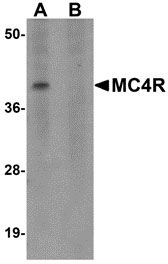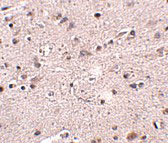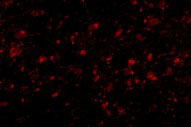MC4R Antibody
- SPECIFICATION
- CITATIONS
- PROTOCOLS
- BACKGROUND

Application
| WB, IHC-P, IF, E |
|---|---|
| Primary Accession | P32245 |
| Other Accession | NP_005903, 119508433 |
| Reactivity | Human, Mouse, Rat |
| Host | Rabbit |
| Clonality | Polyclonal |
| Isotype | IgG |
| Calculated MW | 36943 Da |
| Application Notes | MC4R antibody can be used for detection of MC4R by Western blot at 1 µg/mL. Antibody can also be used for immunohistochemistry starting at 2.5 µg/mL. For immunofluorescence start at 20 µg/mL. |
| Gene ID | 4160 |
|---|---|
| Target/Specificity | MC4R; |
| Reconstitution & Storage | MC4R antibody can be stored at 4℃ for three months and -20℃, stable for up to one year. As with all antibodies care should be taken to avoid repeated freeze thaw cycles. Antibodies should not be exposed to prolonged high temperatures. |
| Precautions | MC4R Antibody is for research use only and not for use in diagnostic or therapeutic procedures. |
| Name | MC4R |
|---|---|
| Function | Hormone receptor that acts as a key component of the leptin- melanocortin pathway at the intersection of homeostatic maintenance of energetic state (PubMed:32327598, PubMed:33858992). Plays a role in regulating food intake: activation by a stimulating hormone such as anorexigenic alpha-melanocyte stimulating hormone (alpha-MSH) inhibits appetite, whereas binding to a natural antagonist like Agouti-related protein/AGRP promotes appetite. G-protein-coupled receptor that activates conventional Galphas signaling leading to induction of anorexogenic signaling in the hypothalamus to result in negative energy balance (PubMed:33858992). Regulates the firing activity of neurons from the hypothalamus by alpha-MSH and AGRP independently of Galphas signaling by ligand-induced coupling of closure of inwardly rectifying potassium channel KCNJ13 (By similarity). In intestinal epithelial cells, plays a role in the inhibition of hepatic glucose production via nesfatin-1/NUCB2 leading to increased cyclic adenosine monophosphate (cAMP) levels and glucagon-like peptide 1 (GLP-1) secretion in the intestinal epithelium (PubMed:39562740). |
| Cellular Location | Cell membrane; Multi-pass membrane protein |
| Tissue Location | Brain, placental, and gut tissues. |

Thousands of laboratories across the world have published research that depended on the performance of antibodies from Abcepta to advance their research. Check out links to articles that cite our products in major peer-reviewed journals, organized by research category.
info@abcepta.com, and receive a free "I Love Antibodies" mug.
Provided below are standard protocols that you may find useful for product applications.
Background
MC4R Antibody: The melanocortin-4 receptor (MC4R) is a member of the superfamily of seven transmembrane G-protein coupled receptors that are involved in multiple signal transduction pathways including the cAMP and MAPK signaling pathways. It is thought that the melanocortin system modulates energy expenditure and insulin sensitivity; activation of the MC4R results in the inhibition of c-Jun N-terminal kinase (JNK) activity and promotes insulin signaling. MC4R-null mice display maturity onset obesity characterized by hyperphagia, increased adiposity, hyperinsulinaemia and hyperleptinaemia, suggesting that like other obesity-linked genes such as FTO, PTER, and NPC1, MC4R is a potential candidate target for the treatment of obesity.
References
Gantz I, Miwa H, Konda Y, et al. Molecular cloning, expression, and gene localization of a fourth melanocortin receptor. J. Biol. Chem.1993; 268:15174-9.
Vongs A, Lynn NM, and Rosenblum CI. Activation of MAP kinase by MC4-R through PI3 kinase. Regul. Pept.2004; 120:113-8.
Cone H. Anatomy and regulation of the central melanocortin system. Nat. Neurosci.2005; 8:571-8.
Chai B, Li J-Y, Zhang W, et al. Melanocartin-4 receptor activation inhibits c-Jun N-terminal kinase activity and promotes insulin signaling. Peptides2009; 30:1098-10
If you have used an Abcepta product and would like to share how it has performed, please click on the "Submit Review" button and provide the requested information. Our staff will examine and post your review and contact you if needed.
If you have any additional inquiries please email technical services at tech@abcepta.com.













 Foundational characteristics of cancer include proliferation, angiogenesis, migration, evasion of apoptosis, and cellular immortality. Find key markers for these cellular processes and antibodies to detect them.
Foundational characteristics of cancer include proliferation, angiogenesis, migration, evasion of apoptosis, and cellular immortality. Find key markers for these cellular processes and antibodies to detect them. The SUMOplot™ Analysis Program predicts and scores sumoylation sites in your protein. SUMOylation is a post-translational modification involved in various cellular processes, such as nuclear-cytosolic transport, transcriptional regulation, apoptosis, protein stability, response to stress, and progression through the cell cycle.
The SUMOplot™ Analysis Program predicts and scores sumoylation sites in your protein. SUMOylation is a post-translational modification involved in various cellular processes, such as nuclear-cytosolic transport, transcriptional regulation, apoptosis, protein stability, response to stress, and progression through the cell cycle. The Autophagy Receptor Motif Plotter predicts and scores autophagy receptor binding sites in your protein. Identifying proteins connected to this pathway is critical to understanding the role of autophagy in physiological as well as pathological processes such as development, differentiation, neurodegenerative diseases, stress, infection, and cancer.
The Autophagy Receptor Motif Plotter predicts and scores autophagy receptor binding sites in your protein. Identifying proteins connected to this pathway is critical to understanding the role of autophagy in physiological as well as pathological processes such as development, differentiation, neurodegenerative diseases, stress, infection, and cancer.




